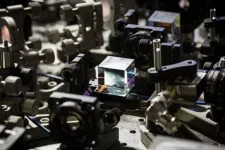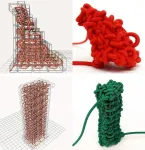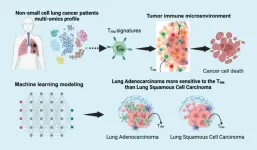(Press-News.org) HERSHEY, Pa. — Every disease is shaped by a genetic component as well as environmental factors like air pollution, climate and socioeconomic status. However, the extent to which genetics or environment plays a role in disease risk — and how much can be attributed to each — isn’t well understood. As such, the actions individuals can take to reduce their risk for disease aren’t often clear.
A team led by Penn State College of Medicine researchers found a way to tease apart genetic and environmental effects of disease risk using a large, nationally representative sample. They found that, in some cases, previous assessments overstated the contribution of one’s genes to disease risk and that lifestyle and environmental factors play a larger role than previously believed. Unlike genetics, environmental factors, like exposure to air pollution, can be more easily modified. That means there are potentially more opportunities to mitigate disease risk. The researchers published their work in Nature Communications.
“We’re trying to disentangle how much genetics and how much the environment influences the development of disease. If we more accurately understand how each contributes, we can better predict disease risk and design more effective interventions, particularly in the era of precision medicine,” said Bibo Jiang, assistant professor of public health sciences at the Penn State College of Medicine and senior author of the study.
The researchers said that in the past, it’s been difficult to quantify and measure environmental risk factors since they can encompass everything from diet and exercise to climate. However, if environmental factors aren’t considered in models of disease risk, analyses may falsely attribute the shared disease risks among family members to genetics.
“People living in the same neighborhood share the same level of air pollution, socioeconomic status, access to health care providers and food environment,” said Dajiang Liu, distinguished professor, vice chair for research, director of artificial intelligence and biomedical informatics at the Penn State College of Medicine and co-senior author of the study. “If we can tease apart these shared environments, what’s remaining could more accurately reflect genetic heritability of disease.”
In this study, the team developed a spatial mixed linear effect (SMILE) model that incorporates both genetics and geolocation data. Geolocation — a person’s approximate geographical location — served as a surrogate measure for community-level environmental risk factors.
Using data from IBM MarketScan, a health insurance claims database with electronic health records from more than 50 million individuals from employer-based health insurance policies in the United States, the research team filtered out information for more than 257,000 nuclear families and compiled disease outcomes for 1,083 diseases. They then augmented the data to include publicly available environmental data, including climate and sociodemographic data, as well as levels of particulate matter 2.5 (PM2.5) and nitrogen dioxide (NO2).
The team’s analysis led to more refined estimates of the contributors to disease risk. For example, previous studies concluded that genetics contributed 37.7% of the risk of developing Type 2 diabetes. When the research team reassessed the data, their model, with its consideration of environmental effects, found that the estimated genetic contribution to Type 2 diabetes risk decreased to 28.4%; a bigger share of disease risk can be attributed to environmental factors. Similarly, estimated contribution to obesity risk attributed to genetics decreased from 53.1% to 46.3% when adjusted for environmental factors.
“Previous studies concluded that genetics played a much larger role in disease risk prediction, and our study recalibrated those numbers,” Liu said. “That means that people can stay hopeful even though they have family relatives with Type 2 diabetes, for example, because there's a lot they can do to reduce their own risk.”
The research team also used the data to quantitatively assess whether two specific pollutants in the air — PM2.5 and NO2 — causally influence disease risks. Previous studies, the researchers said, lump PM2.5 and NO2 together as one collective measure of air pollution. However, what they found in this study was that the two pollutants have different and distinct causal relationships with health conditions. For instance, NO2 is shown to directly cause conditions like high cholesterol, irritable bowel syndrome and both Type 1 and Type 2 diabetes, but not PM2.5. PM2.5, on the other hand, may have a more direct causal effect on lung function and sleep disorders.
Ultimately, the researchers said this model will allow for a more in depth look at questions about why some diseases may be more prevalent in certain geographic locations.
Other Penn State authors on the paper include: Havell Markus and Austin Montgomery, both dual medical degree and doctoral degree students at the Penn State College of Medicine; Laura Carrel, professor of biochemistry and molecular biology; Arthur Berg, professor of public health sciences; and Qunhua Li, professor of statistics. Daniel McGuire, who was a doctoral student in the biostatistics program at the time of the research, co-led the study. Co-author Lina Yang and Jingyu Xu, who were doctoral students in the biostatistics program at the time of the research, also contributed to the paper.
The National Institutes of Health and the Penn State College of Medicine’s artificial intelligence and biomedical informatics pilot funding program supported this work in part. Some of the materials employed in this work were provided by the Center for Applied Studies in Health Economics at the Penn State College of Medicine.
END
Genes or environment? A new model for understanding disease risk factors
A new model more accurately predicts how genetics and air pollution levels causally influence disease development; may help better assess disease risk and intervention strategies
2024-07-30
ELSE PRESS RELEASES FROM THIS DATE:
Study reveals impact of concern about misinformation on Americans’ media consumption habits
2024-07-30
Most Americans are aware of fake news and misinformation. In a new study, researchers from the University of Pennsylvania sought to uncover whether the threat of misinformation drives Americans to seek out news sources that reflect their own political beliefs.
The study, published in the Harvard Kennedy School Misinformation Review, found that Democrats, older individuals, and those with higher education levels are more concerned about misinformation in general and that, compared to Republicans, ...
USF students will swab first responder vehicles through a CDC-funded infection control initiative
2024-07-30
TAMPA, Fla. (July 30, 2024) – University of South Florida students are leading infection control training for fire and emergency medical services personnel as part of a groundbreaking initiative supported by a multi-million-dollar cooperative agreement with the Centers for Disease Control and Prevention.
This fall, student research and project assistants will begin swabbing first responder vehicles, ambulances, fire trucks and equipment to identify pathogen exposure risks and enhance training.
“By working on this aspect ...
Grainger Engineers to lead Illinois Quantum and Microelectronics Park, shape the future of quantum computing
2024-07-30
Today, The Grainger College of Engineering at the University of Illinois Urbana-Champaign joined other partners from around the state in officially announcing its leadership role in the Illinois Quantum and Microelectronics Park. The project – a quantum-focused research and development campus in Chicago – will be managed by a University of Illinois-led organization on behalf of the State of Illinois and Governor J.B. Pritzker.
Advances in quantum information science and engineering, together with next generation microelectronics, promise to transform computing, which underpins much of how our modern society operates. Grainger Engineering Associate Dean for Research ...
Research warns of “systematic weaknesses in jury decisions”
2024-07-30
There are “systemic weaknesses” in the way juries make decisions – and these are likely to be contributing to the conviction of innocent people, failures to convict the guilty, and inequalities, new research warns.
The current legal rules involving procedure and evidence are not consistently designed based on robust evidence about how the juries make decisions, but the system could function better, according to a new book.
Dr Rebecca Helm, from the University of Exeter, outlines how juries are likely to struggle to make effective legal decisions in predictable case types, including cases involving sexual offences in which testimony ...
NYU Tandon School of Engineering and Indian Institute of Technology Kanpur announce seven joint research projects launching their new partnership
2024-07-30
NYU Tandon School of Engineering and Indian Institute of Technology Kanpur (IIT Kanpur) have unveiled their inaugural roster of collaborative research projects, the first such initiatives under the broad partnership that NYU and IIT Kanpur established last year.
The seven projects, jointly led by researchers from each institution, aim to advance innovations across vital scientific fields including cybersecurity, biotechnology, artificial intelligence, robotics, and wireless communications.
NYU and IIT Kanpur announced their initial partnership agreement in September 2023, ...
Study finds genetic variant among people who experience a rare recovery from ALS
2024-07-30
DURHAM, N.C. – Though exceedingly rare, some people diagnosed with amyotrophic lateral sclerosis (ALS) partially or fully recover from the lethal neurodegenerative disease.
A better understanding of this baffling phenomenon, reported in medical literature for at least 60 years, could point to potential new treatment approaches. To that end, researchers at Duke Health and St. Jude’s Research Hospital launched a study of ALS recovery patients and found certain genetic factors that appear to protect ...
Watch ut IKEA: CMU Researchers eye knitted furniture
2024-07-30
Yuichi Hirose has a dream — a dream that someday everyone will have access to a machine capable of knitting furniture.
This machine wouldn't just knit the furniture's exterior fabric, but would use knitting to fashion solid three-dimensional chairs, tables and other objects. Tired of that love seat? Just unravel it and reuse the yarn to knit yourself an ottoman.
This new fabrication technique — first envisioned by Hirose, a robotics Ph.D. student in Carnegie Mellon University's School of Computer Science — is called solid knitting. The idea captured his imagination more than a decade ago. And now, working with a research team headed by James ...
Enjoy your work? Don’t sell yourself short. Buyers are willing to pay more for products you enjoy producing
2024-07-30
Researchers from Tilburg University, Northwestern University, and Lehigh University published a new Journal of Marketing study that examines how a seller’s enjoyment in making a product influences buyers’ willingness to pay and the price the seller charges.
The study, forthcoming in the Journal of Marketing, is titled “Production Enjoyment Asymmetrically Impacts Buyers’ Willingness to Pay and Sellers’ Willingness to Charge” and is authored ...
Recent study reveals key immune cells as critical factors in lung cancer prognosis
2024-07-30
(LOS ANGELES, July 30, 2024) – An extensive analytical study performed at the Terasaki Institute and published in Frontiers in Immunology highlights the crucial role of tissue-resident memory T cells and how they influence the immune environment of patients with non-small cell lung cancer and their overall prognosis.
Non-small cell lung cancer accounts for ~85% of lung tumors and is a leading cause of death in adults. Tissue-resident memory T cells, a specialized subset of immune cells residing in peripheral tissues, have been ...
Accuracy of diagnostic blood tests for Alzheimer’s disease varies
2024-07-30
Neurologists diagnose cognitive impairment with a clinical exam of memory and thinking skills. To determine whether Alzheimer’s disease is the cause of the cognitive impairment, evidence of the specific brain changes that characterize Alzheimer’s must be obtained, typically via a brain scan or spinal tap. Identifying people whose cognitive symptoms are due to Alzheimer’s disease is critical now that new Alzheimer’s therapies are available that could change the course of the illness.
To make diagnosis more convenient for patients, many companies have begun selling Alzheimer’s ...
LAST 30 PRESS RELEASES:
Microplastics detected in rural woodland
JULAC and Taylor & Francis sign open access agreement to boost the impact of Hong Kong research
Protecting older male athletes’ heart health
KAIST proposes AI-driven strategy to solve long-standing mystery of gene function
Eye for trouble: Automated counting for chromosome issues under the microscope
The vast majority of US rivers lack any protections from human activities, new research finds
Ultrasound-responsive in situ antigen "nanocatchers" open a new paradigm for personalized tumor immunotherapy
Environmental “superbugs” in our rivers and soils: new one health review warns of growing antimicrobial resistance crisis
Triple threat in greenhouse farming: how heavy metals, microplastics, and antibiotic resistance genes unite to challenge sustainable food production
Earthworms turn manure into a powerful tool against antibiotic resistance
AI turns water into an early warning network for hidden biological pollutants
Hidden hotspots on “green” plastics: biodegradable and conventional plastics shape very different antibiotic resistance risks in river microbiomes
Engineered biochar enzyme system clears toxic phenolic acids and restores pepper seed germination in continuous cropping soils
Retail therapy fail? Online shopping linked to stress, says study
How well-meaning allies can increase stress for marginalized people
Commercially viable biomanufacturing: designer yeast turns sugar into lucrative chemical 3-HP
Control valve discovered in gut’s plumbing system
George Mason University leads phase 2 clinical trial for pill to help maintain weight loss after GLP-1s
Hop to it: research from Shedd Aquarium tracks conch movement to set new conservation guidance
Weight loss drugs and bariatric surgery improve the body’s fat ‘balance:’ study
The Age of Fishes began with mass death
TB harnesses part of immune defense system to cause infection
Important new source of oxidation in the atmosphere found
A tug-of-war explains a decades-old question about how bacteria swim
Strengthened immune defense against cancer
Engineering the development of the pancreas
The Journal of Nuclear Medicine ahead-of-print tip sheet: Jan. 9, 2026
Mount Sinai researchers help create largest immune cell atlas of bone marrow in multiple myeloma patients
Why it is so hard to get started on an unpleasant task: Scientists identify a “motivation brake”
Body composition changes after bariatric surgery or treatment with GLP-1 receptor agonists
[Press-News.org] Genes or environment? A new model for understanding disease risk factorsA new model more accurately predicts how genetics and air pollution levels causally influence disease development; may help better assess disease risk and intervention strategies



